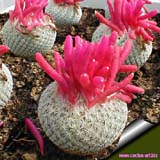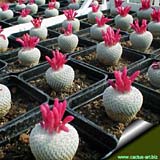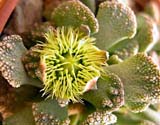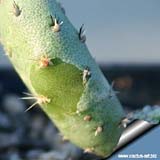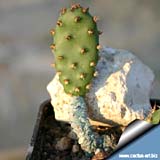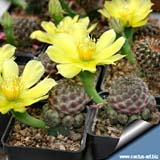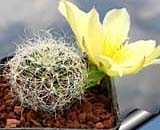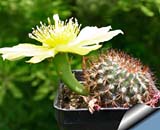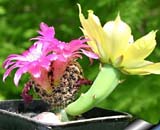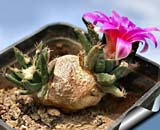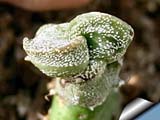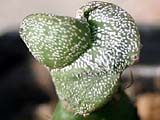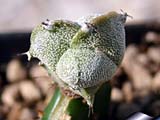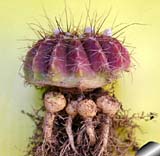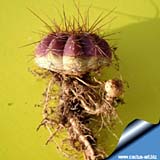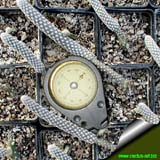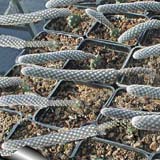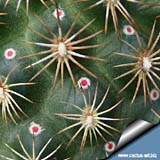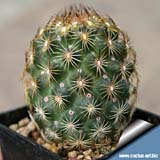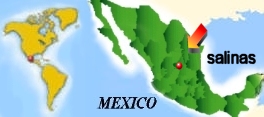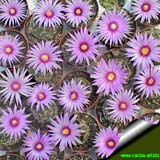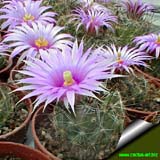 |
 |
CULTIVAR / КУЛЬТИВАР e-Magazine about exotic forms of Cactaceae ENGLISH / RUS-(Win1251) | |||||
| Start page | Authors | Articles | Photogallery | Search | Links | Guestbook | Project by Valery Kalishev |

|
Valentino Vallicelli
Cacti and succulents are amazing plants, a lot of unknown and unusual things can be discovered living with them, in this page we show some curiosities discovered observing our plants. A special thanks to Bernard Bubendorf who sent us a photo of its own odd plant. The page by Valentino Vallicelli Cactus curiosities will be regularly updated with curious photography from our plants collection. EPITHELANTHA MICROMERIS
This bright red fruits last on the plant almost one year!!! The photo on left has been taken on October 01 2003, below you can see the same plant with fruit in April 2003: after 7 month they are still very decorative. New fruits of the year (on the Centre) and old ones (on the edge) are contemporarily present on the plant! On photo 1-2 Epithelantha micromeris SB125 Arteaga, Coahuila, Mexico. October 01 2003 after 8 months the fruit are still bright red.
A VERY BIZARRE FLOWER Titanopsis calcarea "bizarre" (photo 3). I saw on your site that you show some 'curiosity', I joined a photo of a strange flower of Tianopasis calcarea; it is a monstrose and very rare plant sport. Photo by Bernard Bubendorf Site: http://bernard.bubendorf.free.fr. THE CHIMAERICAL CACTUS! A new cactus chimera, Ortegogactus skin on Opuntia body!!!
+ Ortegopuntia cv. "Percy" (photo 4-6). "Chimera" is an organism that is made up of cells of two different origins. Only a very few chimerical cactus are known, this new and very rare plant is a graft hybrid containing cells of Opuntia compressa and Ortegocactus macdougalli. Scientific Name: + Ortegopuntia cv. Percy - Ortegocactus macdougalii + Opuntia compressa. Origin of the chimaera: Fuond and selected in the cactus art nursery in the spring 2004 by Vallicelli Valentino Etymology: A graft-chimaeras can be given their own genus name (which is a combination of the two constituent generic names) preceded by a + sign. + Ortegopuntia derives from the combination of Ortegocactus and Opuntia. Description: This original plant appeared unexpectedly in a grafted plant, the graft-chimaera sprouted up as a small branch from the point of union of the stock and scion from the callus containg tissues of both species. This is a very slow growing plant with an external layer of epidermal cell of Ortegocactus macdougalli that cover a second inner layer of tissues of Opuntia compressa like a glove. The plant colour is the unmistakable grey-blu metallic tone of the Ortegocactus, but the plant shape is that of a minuscule Opuntia with small irregular cladodes up to 3-5 cm of length. This plant is quite unstable and have a tendency to revert to common Opuntia shoots. Cultivation: We have not a long time for testing the cultivation requirements of this brand new chimera. The plant seems of easily cultivation, the main difficulty is to eliminate the shoots that revert to the Opuntia type, it is advisable to water the plant moderately, in fact over-feeding and over-watering may enhance the growth of the more vigorous Opuntia tissues causing the revertion. This is a particularly slow growing plant and needs a sunny and warm exposure, and possibly winter temperature not less than 5-10° C. and good air ventilation. History: Chimaera of plants belonging to the Cactaceae family are very rare and quite unusual in cultivation. The first chimera + Hylocalycium (Hylocereus undatus + Gymnocalycium mihanovichii forma rubra "cv. Red Hibotan"), was described in cactus & succ .J. of America 1987 61- 4 2, Recently some other chimerical cactus have been signaled in internet for example: In some ornamental plants chimaeras may be the result of lengthwise implanting and sophisticated techniques, a possible methods include cutting the stem at the midpoint and combining the lobes of stock and scion. It is supposed that the miscellaneous tissues in the joint point can accrete and give life to an adventitious new plant "chimera". But - as we know - nobody till now has succeeded to make cacti chimera on purpose. Circumstances which cause the chimera to appear include huge numbers of graftings. SULCOREBUTIAS WITH OPUNTIA FLOWERS
A very strange event: various species of Sulcorebutia grafted on Opuntia compressa encourage the grafting stock to bloom... Among so many kinds of cactus grafted on Opuntia compressa only the Sulcorebutias stimulate the grafting stock to bloom. The result is curious and very handsome. A very strange event: various species of Sulcorebutia grafted on Opuntia compressa encourage the grafting stock to bloom... A very curious and handsome blooming event (photo 7-11). Among so many kinds of cactus grafted on Opuntia compressa only the Sulcorebuties stimulate the grafting stock to bloom. The Sulcorebutias probably produce hormones able to activate the flowering of the Opuntia. This is remarkable if we consider the very minute dimension of the Opuntias utilized. The result is curious and very handsome. This is the demonstration that the plants joined by graft constitute a symbiosis in which the two parts influences one to each other, and mutually contribute to sustain the biological process of life like: photosynthesis, water, feeding, blooming etc. They support one to each other in a very collaborative and active way. The two parts are one.
ADVENTITIOUS SHOOTS Ariocarpus agavoides 'Spiny'.
TWO RIBS.... INCREDIBLE! Astrophytum myriostigma cv. Tao (var. bicostatum). The birth of an A. myriostigma bicostatum is really a rare and memorable event. Till now only two plants over thousand plants born with this uncommon feature. A two ribbed myriostigma! a very rare event. (1,5 years old 2,5 cm top view - September 2004) (photo 13-15). Etymology: the variety name bicostatum derives from the Latin prefix "bi" which means "bis, twice, two" and the Latin adjectives "costatus" meaning "ribbed" ( From the Latin word "costa" a rib) " ( The specific name implies: "two ribbed"). The cultivars name has been chosen referring to the Tao symbol ( the image of yang and yin) for its resemblance to the form of this peculiar plant. Scientific Name: Astrophytum myriostigma cv. TAO (forma bicostata)
UNDERGROUND SHOOTS
Notocactus arechavaletai var. limiticola HU179. Shoots, called root suckers - that arise from adventitious buds developing on the root system - occasionally occur in some cactus species when roots have been injured or felled, but this specie produce naturally a large numbers of them and can develop into a small colony. Underground shoots from the roots. The rich magenta colour of the stem is due to a full sun exposure (photo 16). Root suckers arise from adventitious buds developing on the root system (photo 17). Notocactus arechavaletai v. limiticola HU179 Sant'ana do Liveramento, Rio Grande do Sul, Brazil. Scientific Name: Notocactus arechavaletae var. limiticola Ritter 1979 (in: Ritter, Kakteen in Sudamerika, 1: 164, 1979). Field number: HU179 Collector: Horst Ubelmann Locality: Sant'ana do Liveramento, Rio Grande do Sul, Brazil. COMPASS CACTUS
Pterocactus megliolii
Now (October 2003) I also see that the grafted Pterocactus branches spontaneously prunes them selves from the grafting stock: they are deciduous!!! A very fragile corky necrotic brown zone has been formed in the grafting point of union and the Pterocactus shoots are easily detached from the under-stock-support…. RED POINT?
Coryphantha echinoidea SB 26 Salinas, San Luis Potosi, Mexico. Many cacti have estrafloral nectaries (gland producing a sugary nectar that attracts pugnacious ants which defend the plants by herbivore insects) The red nectaries of C. echinoidea are particularly decorative. The red extrafloral nectaries attract the ants that defend the plant against dangerous herbivor insects. Scientific Name: Coryphantha echinoidea (Quehl 1913) Britton & Rose 1923 Subgenus Neocoryphantha (gland-bearing Coryphantas). Field number: SB 26. Collector: Steven Brack. Locality: Salinas, SLP, Mexico.
Habitat: It is found in the Mexican state of San Luis Potosi and the bordering regions of Guanajuato and Nuevo Leon, subsequent to its earliest description it is assumed to grow in the East of Durango, but it is almost certainly not found there. Etymology:
The specific name derives from "echinoidea" a class of (spiny) marine invertebrates, (e.g. starfish, sea urchins and sea cucumbers) referring to the porrett central spines reminiscent of a hedgehog (The specific name implies: "like an (spiny) sea urchin"). Description: Small solitary, globous, to egg-shaped stems up to 6 cm high and diameter. 20-24 radials, 1 to 3 porrect central spines 1-1.5 cm. in mature specimens; This cactus produces well marked red nectary glands on the tubercles (extra-floral structure secreting nectar) that attract ants. Flowers are large and yellow (5- 6 cm diameter) with - like the ones of the related C . vaupeliana and C. glanduligera - a sweet fragrance. Fruits are green and club-shaped. All Coryphanthas develop woolly grooves running down the tubercles as they grow towards maturity and plants will not flourish until this has happened which can take 4 years or more. Cultivation: Easily grown in normal cactus compost, requires good drainage. Water in moderation, keep drier in winter. Full sun to partial shade. In humid conditions, the exudation of nectar (if not completely removed by ants) can cause the formation of mould which leads to ugly black-colouring of the epidermis. To prevent this, spray the plant with water to remove the nectar. And provide very good ventilation. Notes: The Subgenus Neocoryphantha Backeberg is characterised by the presence of extra floral nectaries; they are glands typically located in the tubercle-grooves or in the axils. These nectary-glands are red, orange or yellow and exude in the summer and autumn a viscous juice (nectar) with a high sugar-content. These glands represent a sophisticated strategy for ant attraction.
DELICIOUS MAMMILLARIA BERRIES!!! Mammillaria wrightii SB 86 Manzano Mts, NM, USA. This winter hardy Mammillaria produce very big fruits that taste of gooseberry (photo 22-24). Big fruits, big flowers!!! This winter hardy Mammillaria produce fruits of a very pleasant taste. Very choicest.
|
|
Copyright © Valery Kalishev, Chelyabinsk, Russia, 2000-2005
Design and hosting - Peter Lapshin, 2002-2005 |
